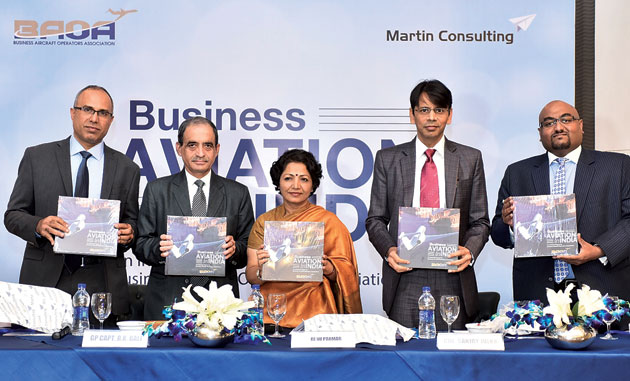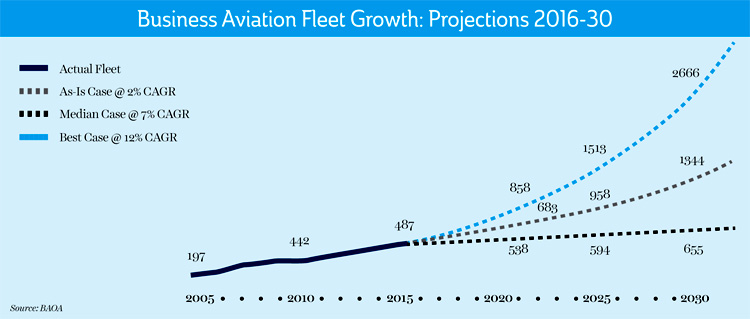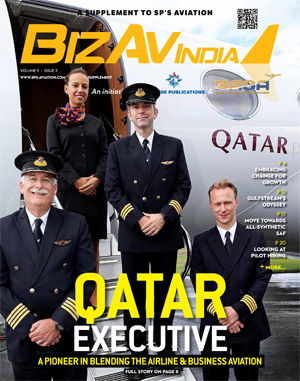BAOA Brings Out the First Ever Industry Report on Business Aviation in India
“We hope this report leads to action. This report will be widely distributed in the government, in DGCA, operators and others and we hope this report will make a difference.”
— Jayant Nadkarni, President, Business Aircraft Operators Association

The Indian Government’s Regional Connectivity Scheme (RCS) has created a lot of buzz in the media. Certainly, this plan has the opportunity to connect more of India’s population via air transport. At the same time, there has to be a growing recognition that business aviation is a key tool to enhance business productivity and thereby contributing to the country’s economy.
Business aviation in India continues to remain much below its potential. In sharp contrast to the growth of scheduled airlines, business aviation in India over the last five years charted a meagre 2 per cent growth. Provided certain immediate and long-term actions are taken, India is looking at a relatively conservative fleet growth projections of about 7 per cent over a long period, a median between best case of 12 per cent and as is case today of 2 per cent, according to the first industry report released by the Business Aircraft Operators Association (BAOA) along with its knowledge partner Martin Consulting LLC.
“The aim of the BAOA Industry Report is to present and make aware the contribution, role and strategic fulcrum that business aviation has played with shaping the India of today. Business aviation is no longer a corporate status symbol, but an imperative business tool needed by captains of industry and national leaders to grow in a highly competitive global business environment,” said Jayant Nadkarni, President, BAOA.
Elaborating the unique contents of the report and how it is different, Nadkarni added, “What is really different is that it gives an overall perspective. There was no overall perspective given in the past. Business aviation and scheduled airlines are two sides of the same coin. The report is basically targeted at solutions and how to move forward with an overall perspective. Also, the report brings in an international perspective. We have been in touch with IBAC (International Business Aviation Council) and its members and the report gives a global perspective on how things are done while not forgetting the Indian perspective. The big reason why this report is different! People would want to hold on to this report. Read it repeatedly and keep it as a reference for the future. We hope this report leads to action. This report will be widely distributed in the government, in the Directorate General of Civil Aviation (DGCA), operators and others and we hope this report will make a difference.”
Commenting on the state of business aviation and how this report came about, Nadkarni said, “We can really grow and a lot depends upon how we move to dismantle various rules and infrastructure hurdles. We really need to move it up. It is sad that a country that is growing at 7.5 per cent GDP for so long and has 20 per cent plus growth for the scheduled airlines has such a small growth in business aviation. This does not happen anywhere else in the world. This report is useful in that connection”. He went on to acknowledge the contributions made by Rohit Kapur, former President BAOA, Commander Pradeep Agarwal, Colonel Sanjay Julka and Mark D. Martin of Martin Consulting for their initiative, time and efforts in coming out with this report.
The report highlights examples of efficiencies imparted by business aviation, and how this sector makes the country more stable and secure, as employment and economic sustenance is provided to people through industries that are set up by businesses. It enhances economic development which goes on to benefit the common man and a resurgent India. This was showcased by Colonel Sanjay Julka, Vice President, BAOA, when he presented the case of Raigarh and how business aviation indirectly promoted the growth of this city.
“What emerges from this report is a powerful message. That message is business aviation is the catalyst India needs to grow and attain its regional and global supremacy; and we are firm in our judgement that the challenges and hurdles this industry faces must not be overlooked as that may be construed as being restrictive and not conducive to growing India,” said Mark D. Martin, founder and CEO, Martin Consulting LLC.
Admitting that business aviation growth rate in India has not kept pace with the GDP growth and industrial growth, Dr Renu Parmar, Senior Economic Advisor, Ministry of Civil Aviation, invited BAOA to highlight the major concerns of the sector. “What are the issues, not the list but the main two or three issues that we need to address for business aviation?”
The new National Civil Aviation Policy is a step in the right direction, which has touched upon every sector of aviation, but has clearly left out business aviation. This is due to the incorrect perception that the sector only benefits the affluent, who can afford higher costs and thus can be ignored. It is not appreciated that both scheduled airlines as well as business aviation are integral parts of public air transportation in any nation. You cannot do without either one. Business aviation’s immense contribution to India’s economic growth story remains grossly undervalued and unappreciated. Given the right impetus, the sector has the potential to create a revolution in regional connectivity and economic benefits for the country, the report concluded.






